Alfa Romeo Giulietta 2014 Owner's Manual
Manufacturer: ALFA ROMEO, Model Year: 2014, Model line: Giulietta, Model: Alfa Romeo Giulietta 2014Pages: 280, PDF Size: 6.65 MB
Page 221 of 280
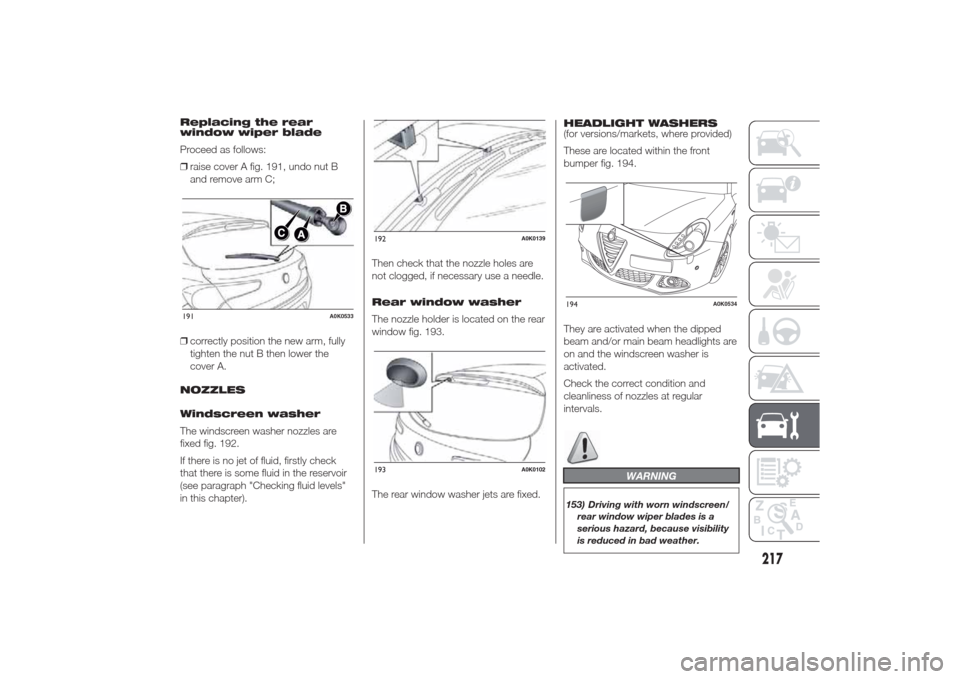
Replacing the rear
window wiper blade
Proceed as follows:
❒raise cover A fig. 191, undo nut B
and remove arm C;
❒correctly position the new arm, fully
tighten the nut B then lower the
cover A.
NOZZLES
Windscreen washer
The windscreen washer nozzles are
fixed fig. 192.
If there is no jet of fluid, firstly check
that there is some fluid in the reservoir
(see paragraph "Checking fluid levels"
in this chapter).Then check that the nozzle holes are
not clogged, if necessary use a needle.
Rear window washer
The nozzle holder is located on the rear
window fig. 193.
The rear window washer jets are fixed.HEADLIGHT WASHERS
(for versions/markets, where provided)
These are located within the front
bumper fig. 194.
They are activated when the dipped
beam and/or main beam headlights are
on and the windscreen washer is
activated.
Check the correct condition and
cleanliness of nozzles at regular
intervals.
WARNING
153) Driving with worn windscreen/
rear window wiper blades is a
serious hazard, because visibility
is reduced in bad weather.
191
A0K0533
192
A0K0139
193
A0K0102
194
A0K0534
217
Page 222 of 280
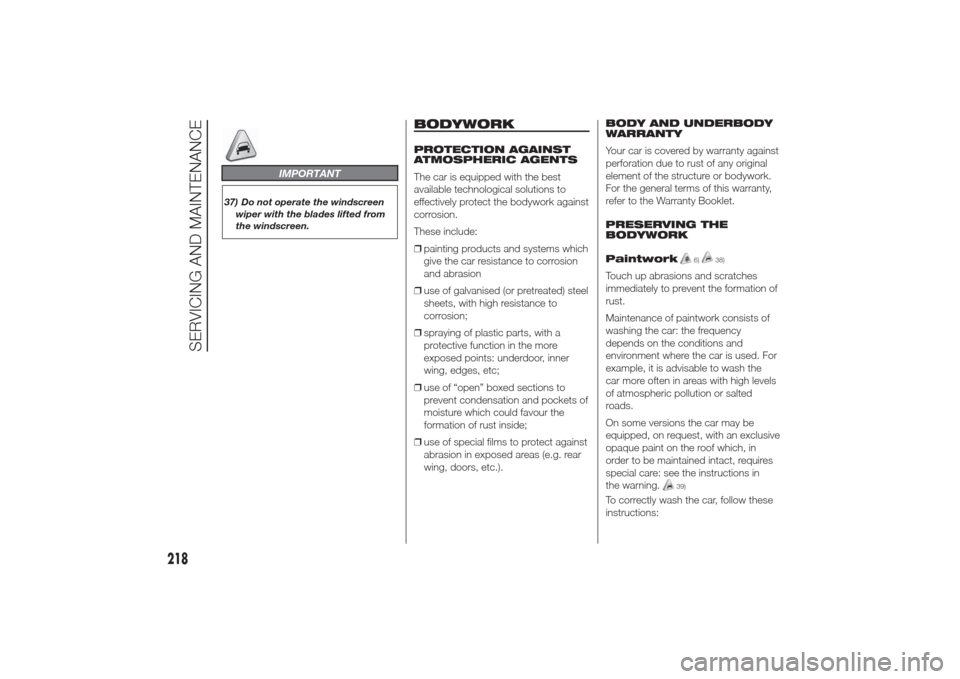
IMPORTANT
37) Do not operate the windscreen
wiper with the blades lifted from
the windscreen.
BODYWORKPROTECTION AGAINST
ATMOSPHERIC AGENTS
The car is equipped with the best
available technological solutions to
effectively protect the bodywork against
corrosion.
These include:
❒painting products and systems which
give the car resistance to corrosion
and abrasion
❒use of galvanised (or pretreated) steel
sheets, with high resistance to
corrosion;
❒spraying of plastic parts, with a
protective function in the more
exposed points: underdoor, inner
wing, edges, etc;
❒use of “open” boxed sections to
prevent condensation and pockets of
moisture which could favour the
formation of rust inside;
❒use of special films to protect against
abrasion in exposed areas (e.g. rear
wing, doors, etc.).BODY AND UNDERBODY
WARRANTY
Your car is covered by warranty against
perforation due to rust of any original
element of the structure or bodywork.
For the general terms of this warranty,
refer to the Warranty Booklet.
PRESERVING THE
BODYWORK
Paintwork
6)
38)
Touch up abrasions and scratches
immediately to prevent the formation of
rust.
Maintenance of paintwork consists of
washing the car: the frequency
depends on the conditions and
environment where the car is used. For
example, it is advisable to wash the
car more often in areas with high levels
of atmospheric pollution or salted
roads.
On some versions the car may be
equipped, on request, with an exclusive
opaque paint on the roof which, in
order to be maintained intact, requires
special care: see the instructions in
the warning.
39)
To correctly wash the car, follow these
instructions:
218
SERVICING AND MAINTENANCE
Page 223 of 280

❒remove the aerial from the roof when
using a carwash;
❒if high pressure jets or cleaners are
used to wash the car, keep a
distance of at least 40 cm from the
bodywork to avoid damage or
alteration. Bear in mind that a build
up of water could cause damage
to the car in the long term;
❒wash the bodywork using a low
pressure jet of water;
❒wipe a sponge with a slightly soapy
solution over the bodywork,
frequently rinsing the sponge;
❒rinse well with water and dry with a
jet of air or a chamois leather.
Dry the less visible parts (e.g. door
frames, bonnet, headlight frames, etc.)
with special care, as water may
stagnate more easily in these areas. Do
not wash the car after it has been left
in the sun or with the bonnet hot:
this may alter the shine of the
paintwork.
Exterior plastic parts must be cleaned
in the same way as the rest of the car.IMPORTANT
Avoid parking under trees; the resin
dropped by trees makes the paintwork
go opaque and increases the possibility
of corrosion.
Bird droppings must be washed off
immediately and thoroughly as the acid
they contain is particularly aggressive.
Windows
Use specific detergents and clean
cloths to prevent scratching or altering
the transparency.
IMPORTANT Wipe the rear window
inside gently with a cloth following the
direction of the filaments to avoid
damaging the heating device.
Front headlights
Use a soft cloth soaked in water and
detergent for washing cars.
IMPORTANT Never use aromatic
substances (e.g. petrol) or ketenes (e.g.
acetone) for cleaning the plastic lenses
of the front headlights.
IMPORTANT When cleaning with a
pressure washer, keep the water jet at
least 20 cm away from the headlights.Engine compartment
At the end of every winter, wash the
engine compartment thoroughly, taking
care not to aim the jet of water directly
at the electronic control units or at
the windscreen wiper motors. Have this
operation performed at a specialised
workshop.
IMPORTANT The washing should take
place with the engine cold and the
ignition key in the STOP position. After
the washing operation, make sure
that the various protections (e.g. rubber
caps and guards) have not been
removed or damaged.
IMPORTANT
6) Detergents cause water pollution.
Only wash your car in areas
equipped to collect and treat
wastewater from this type
of activity.
219
Page 224 of 280
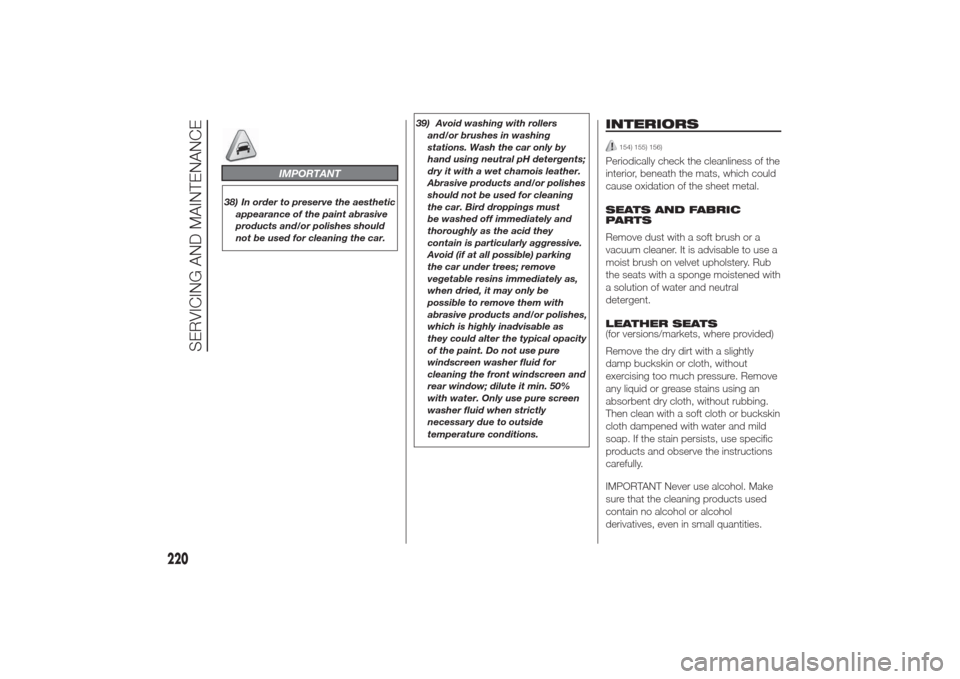
IMPORTANT
38) In order to preserve the aesthetic
appearance of the paint abrasive
products and/or polishes should
not be used for cleaning the car.39) Avoid washing with rollers
and/or brushes in washing
stations. Wash the car only by
hand using neutral pH detergents;
dry it with a wet chamois leather.
Abrasive products and/or polishes
should not be used for cleaning
the car. Bird droppings must
be washed off immediately and
thoroughly as the acid they
contain is particularly aggressive.
Avoid (if at all possible) parking
the car under trees; remove
vegetable resins immediately as,
when dried, it may only be
possible to remove them with
abrasive products and/or polishes,
which is highly inadvisable as
they could alter the typical opacity
of the paint. Do not use pure
windscreen washer fluid for
cleaning the front windscreen and
rear window; dilute it min. 50%
with water. Only use pure screen
washer fluid when strictly
necessary due to outside
temperature conditions.
INTERIORS
154) 155) 156)
Periodically check the cleanliness of the
interior, beneath the mats, which could
cause oxidation of the sheet metal.
SEATS AND FABRIC
PARTS
Remove dust with a soft brush or a
vacuum cleaner. It is advisable to use a
moist brush on velvet upholstery. Rub
the seats with a sponge moistened with
a solution of water and neutral
detergent.
LEATHER SEATS
(for versions/markets, where provided)
Remove the dry dirt with a slightly
damp buckskin or cloth, without
exercising too much pressure. Remove
any liquid or grease stains using an
absorbent dry cloth, without rubbing.
Then clean with a soft cloth or buckskin
cloth dampened with water and mild
soap. If the stain persists, use specific
products and observe the instructions
carefully.
IMPORTANT Never use alcohol. Make
sure that the cleaning products used
contain no alcohol or alcohol
derivatives, even in small quantities.
220
SERVICING AND MAINTENANCE
Page 225 of 280
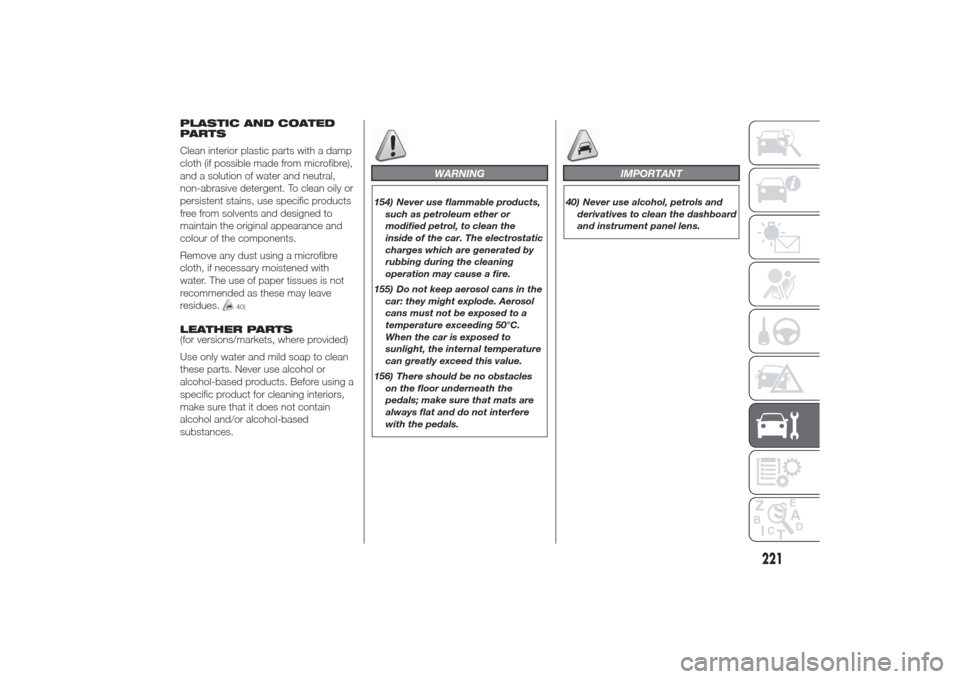
PLASTIC AND COATED
PARTS
Clean interior plastic parts with a damp
cloth (if possible made from microfibre),
and a solution of water and neutral,
non-abrasive detergent. To clean oily or
persistent stains, use specific products
free from solvents and designed to
maintain the original appearance and
colour of the components.
Remove any dust using a microfibre
cloth, if necessary moistened with
water. The use of paper tissues is not
recommended as these may leave
residues.
40)
LEATHER PARTS
(for versions/markets, where provided)
Use only water and mild soap to clean
these parts. Never use alcohol or
alcohol-based products. Before using a
specific product for cleaning interiors,
make sure that it does not contain
alcohol and/or alcohol-based
substances.
WARNING
154) Never use flammable products,
such as petroleum ether or
modified petrol, to clean the
inside of the car. The electrostatic
charges which are generated by
rubbing during the cleaning
operation may cause a fire.
155) Do not keep aerosol cans in the
car: they might explode. Aerosol
cans must not be exposed to a
temperature exceeding 50°C.
When the car is exposed to
sunlight, the internal temperature
can greatly exceed this value.
156) There should be no obstacles
on the floor underneath the
pedals; make sure that mats are
always flat and do not interfere
with the pedals.
IMPORTANT
40) Never use alcohol, petrols and
derivatives to clean the dashboard
and instrument panel lens.
221
Page 226 of 280

222
This page is intentionally left blank
Page 227 of 280
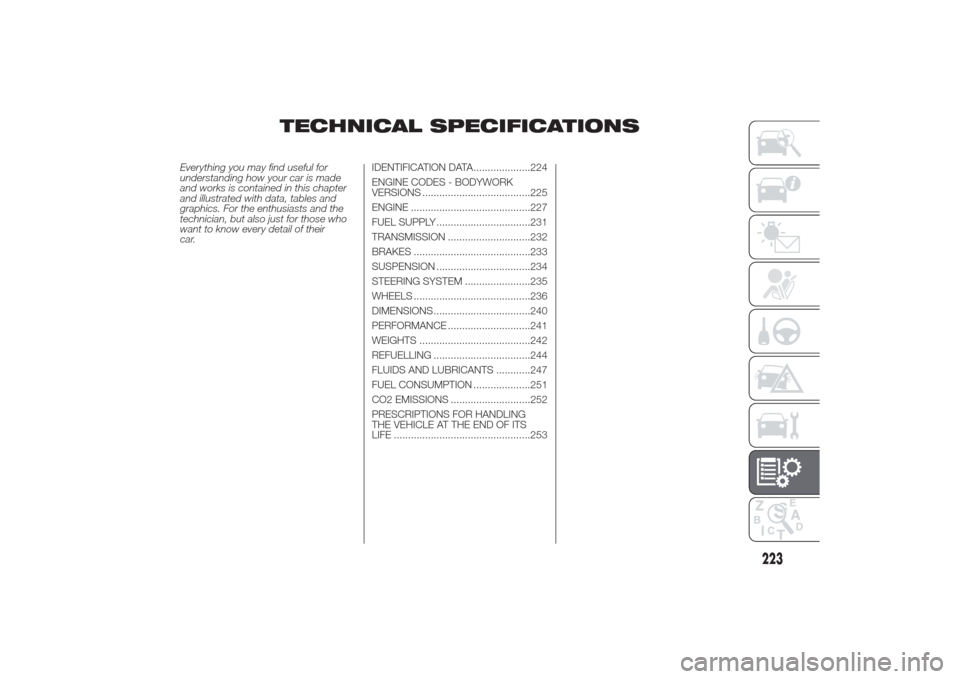
TECHNICAL SPECIFICATIONS
Everything you may find useful for
understanding how your car is made
and works is contained in this chapter
and illustrated with data, tables and
graphics. For the enthusiasts and the
technician, but also just for those who
want to know every detail of their
car.IDENTIFICATION DATA....................224
ENGINE CODES - BODYWORK
VERSIONS ......................................22
ENGINE ..........................................227
FUEL SUPPLY .................................231
TRANSMISSION .............................232
BRAKES .........................................233
SUSPENSION .................................23
STEERING SYSTEM .......................235
WHEELS .........................................236
DIMENSIONS ..................................240
PERFORMANCE .............................241
WEIGHTS .......................................242
REFUELLING ..................................244
FLUIDS AND LUBRICANTS ............247
FUEL CONSUMPTION ....................25
CO2 EMISSIONS ............................252
PRESCRIPTIONS FOR HANDLING
THE VEHICLE AT THE END OF ITS
LIFE ................................................253
223
5
4
1
Page 228 of 280

IDENTIFICATION
DATAThe identification data of the car are:
❒V.I.N. plate;
❒Chassis marking;
❒Body paintwork identification plate;
❒Engine marking.
V.I.N. PLATE
This plate is fitted to the engine
compartment front crossmember and
contains the following data fig. 195:BType-approval number.CVehicle type identification codeDChassis serial number.EMaximum authorised weight of
vehicle fully ladenFMaximum authorised weight of
vehicle fully laden plus trailer.
GMaximum permitted weight on first
(front) axleHMaximum permitted weight on
second (rear) axleIEngine type.LBodywork version code.M
Spares number.
NCorrect value of smoke coefficient
(for diesel engines)
CHASSIS MARKING
This is printed on the passenger
compartment floor, near the front right
seat.
Slide the flap A fig. 196 forward to
access.
The marking includes:
❒vehicle type (ZAR 940000);
❒chassis serial number.BODYWORK PAINT
IDENTIFICATION PLATE
It is applied under the bonnet and
shows the following data fig. 197:
APaint manufacturer.
BColour name.
CFiat colour code.
DRespray and touch up code.
ENGINE MARKING
This is stamped on the cylinder block
and gives the model and the chassis
serial number.
195
A0K0024
197
A0K0025
224
TECHNICAL SPECIFICATIONS
196
A0K0750
Page 229 of 280
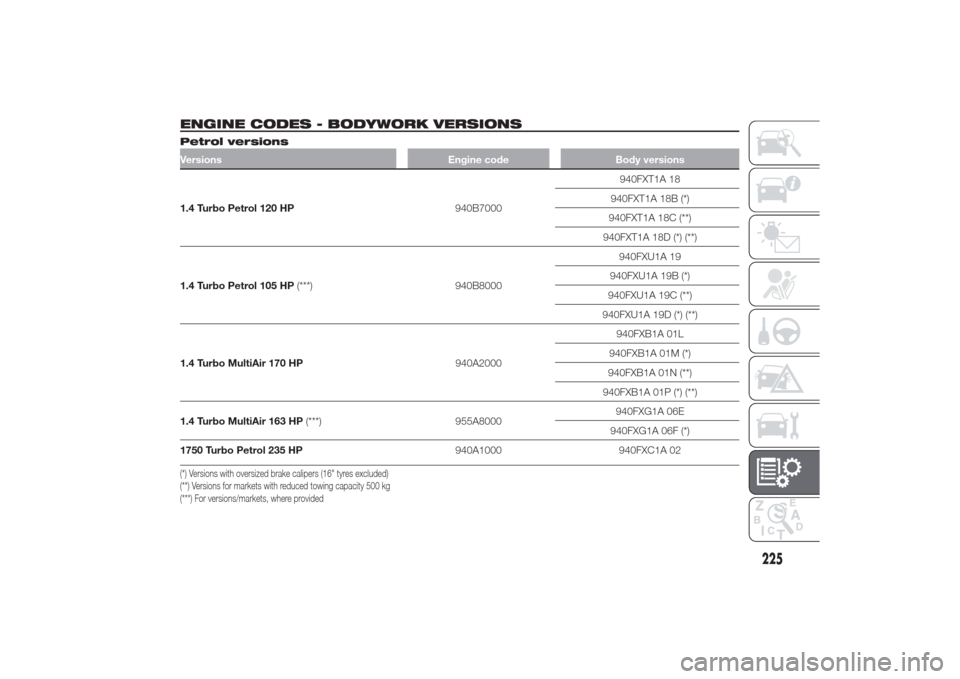
ENGINE CODES - BODYWORK VERSIONSPetrol versionsVersions Engine code Body versions1.4 Turbo Petrol 120 HP940B7000940FXT1A 18
940FXT1A 18B (*)
940FXT1A 18C (**)
940FXT1A 18D (*) (**)
1.4 Turbo Petrol 105 HP(***) 940B8000940FXU1A 19
940FXU1A 19B (*)
940FXU1A 19C (**)
940FXU1A 19D (*) (**)
1.4 Turbo MultiAir 170 HP940A2000940FXB1A 01L
940FXB1A 01M (*)
940FXB1A 01N (**)
940FXB1A 01P (*) (**)
1.4 Turbo MultiAir 163 HP(***) 955A8000940FXG1A 06E
940FXG1A 06F (*)
1750 Turbo Petrol 235 HP940A1000 940FXC1A 02(*) Versions with oversized brake calipers (16" tyres excluded)
(**) Versions for markets with reduced towing capacity 500 kg
(***) For versions/markets, where provided
225
Page 230 of 280
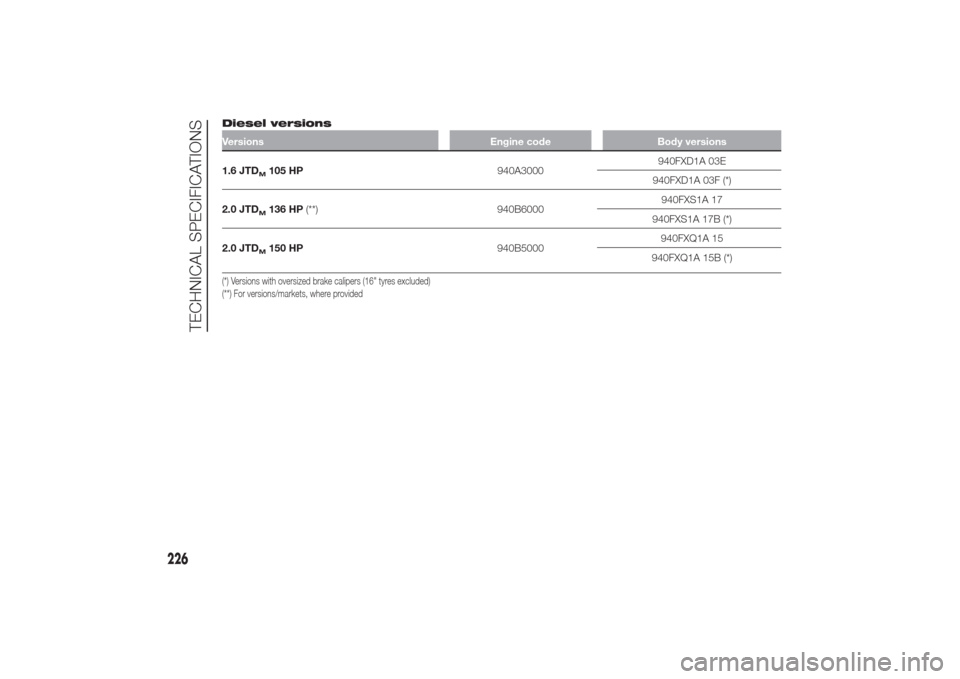
Diesel versionsVersions Engine code Body versions1.6 JTD
M105 HP940A3000940FXD1A 03E
940FXD1A 03F (*)
2.0 JTDM136 HP(**) 940B6000940FXS1A 17
940FXS1A 17B (*)
2.0 JTDM150 HP940B5000940FXQ1A 15
940FXQ1A 15B (*)
(*) Versions with oversized brake calipers (16" tyres excluded)
(**) For versions/markets, where provided
226
TECHNICAL SPECIFICATIONS